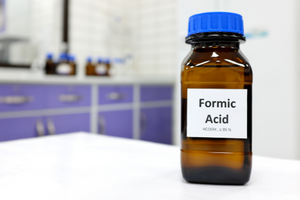If you have ever fallen into nettles or have been bitten by an ant, you learnt what formic acid was the hard way. The substance was first discovered and named by a seventeenth-century English naturalist, John Ray, who experimented on dead ants. In our article, we will look for answers to the following questions: what is formic acid – what is it used for, what are its chemical and physical properties.

What is formic acid and how is it produced?
Formic acid (in Latin: Acidum formicum) is also called methanoic acid or hydrogen carboxylic acid. Together with butyric and acetic acids, it belongs to the group of carboxylic acids, which are the simplest organic chemical compounds formed from hydrocarbons that are known to people.
How can we produce formic acid? The chemical formula of this compound is HCOOH – it is a derivative of:
- a reaction of carbon monoxide and methanol,
- a reaction of carbon monoxide and sodium hydroxide or:
- a result of the process of oxidation of hydrocarbons.
If anybody thinks that ants or nettles are needed for the mass production of formic acid, we reply: nothing could be further from the truth! The acid is produced from chemical intermediates obtained under laboratory conditions.
Formic acid – physical and chemical properties
What are the physical properties of formic acid? It is a colourless caustic liquid with a pungent odour. The melting point of this compound is 8.6°C, and the boiling point is 100.6°C. What else distinguishes formic acid? Other characteristic physical properties of methanoic acid include:solubility in water, benzene and ethyl alcohol and the corrosive effect.
The attention of manufacturers in multiple industries is particularly drawn to the specific chemical properties of formic acid, such as: the capability to increase the corrosion rate of various materials, electric conduction or fungicidal and bactericidal properties. The acid and caustic liquid irritates the mucosa in humans and may cause severe allergic reactions, swelling and skin redness, so you need to exercise extreme caution when handling HCOOH.
Formic acid: use in industry
Manufacturers and researchers in the industrial sector keep coming up with new ideas for using formic acid. At present, this organic compound is used as:
- an intermediate for cleaning, tanning or acidifying preparations,
- a cleaner used to clear different types of industrial installations,
- an additive for greases,
- an ingredient of medicines for rheumatism or vasoconstricting medicines,
- an additive for animal feeds and fungicides,
- an ingredient of cosmetics for body care and regeneration.
Formic acid – industrial chemistry
You can find methanoic acid nowadays in any professional and well-equipped laboratory. It is a valued chemical reagent widely used in the chemical industry. It is required for tests, experiments, research and on-going quality analyses of different industrial processes and products.
Formic acid is often used in fungicides. As you select such agents, opting for tried and tested products developed by specialists is advisable. The product range offered by the PCC Group includes an entire assortment of high quality fungicides. ROKAnol P is a highly recommended preparation.
Another process that uses formic acid is wool mordanting performed during dyeing. Before you colour wool, first you need to wash it. The PCC Group’s product portfolio also includes preparations used for this purpose e.g. EXOclean TPW.
E236, i.e. formic acid in food
Carboxylic acids are used very often in the food industry, and formic acid is used for food conservation. Labels on foodstuffs such as: pickled fish, juices, pickled fruits and vegetables, jelly candies or vegetable/fruit purées mention an additive called E236 – this abbreviation stands for formic acid. The odour of E236 is usually undetectable and a low concentration of the acid does not affect the functioning of the human body.
The presence of formic acid keeps food fresh for longer and helps it counter the attacks of pathogenic fungi, moulds and bacteria. The preservation of foodstuffs with HCOOH facilitates storage and transportation, especially as regards perishables with short expiry dates.

